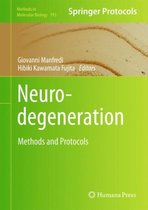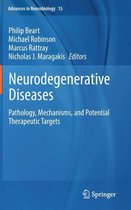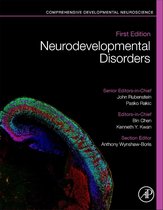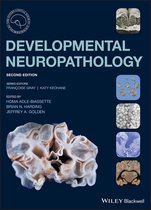Neurodegeneration Metallostasis and Proteostasis
Afbeeldingen
Sla de afbeeldingen overArtikel vergelijken
- Engels
- Hardcover
- 9781849730501
- 04 juli 2011
- 270 pagina's
Royal society of chemistry
(Bron: Wikipedia. Beschikbaar onder de licentie Creative Commons Naamsvermelding/Gelijk delen.)"
Samenvatting
This exemplary book gives an up-to-date perspective on the role of metal ions in neurodegeneration.
Since Alois Alzheimer described the results of his postmortem studies in 1906, significant strides have been made in understanding the pathogenesis of neurodegenerative diseases. Substantial evidence has accumulated indicating that diverse neurodegenerative disorders might share a common pathological mechanism: the misfolding, aggregation and accumulation of proteins (termed "amyloid") in the brain. Metal ions have long been thought to catalyze protein misfolding initiating a cascade of events resulting in oxidative damage and neurodegeneration. They have, consequently, been seen as a suitable pharmacological target. However, drugs aimed at simply removing excess metals or interfering in amyloid deposition were unsuccessful and scientists have been forced to review the classical hypothesis. The latest advances suggest that deficiencies in protein homeostasis may lead to cell dysfunction and disease. Furthermore, small molecules with the potential to control metal homeostasis, or metallostasis, are expected to provide the framework for the design of novel proteostasis regulators. This book provides an up-date on the latest developments in this fast moving field. Traditional views concerning the relationship between the physio-pathological cycles of copper, zinc, iron, aluminium and the evolution of life, are compared with emerging ideas in the neuroscience of metal ions. Topics covered emphasize the importance of metals and oxidation chemistry to neuroscientists as well as providing a wider, multidisciplinary background to chemists who are attracted by these fascinating subjects. The text starts with a chapter on chemical evolution, the brain and metallomics which describes the brain's natural defences to adverse conditions. It then goes on to cover the chemistry and biology of proteostasis, environmental factors, and the role played by membranes in protein misfolding. The remaining chapters cover the role of metals and oxidative stress in Alzheimer's Disease, Parkinsonism, ALS and other neurodegenerative diseases. The book is suitable for academics, those working in industry, and postgraduate students.
Since Alois Alzheimer described the results of his postmortem studies in 1906, significant strides have been made in understanding the pathogenesis of neurodegenerative diseases. Substantial evidence has accumulated indicating that diverse neurodegenerative disorders might share a common pathological mechanism: the misfolding, aggregation and accumulation of proteins (termed "amyloid") in the brain. Metal ions have long been thought to catalyze protein misfolding initiating a cascade of events resulting in oxidative damage and neurodegeneration. They have, consequently, been seen as a suitable pharmacological target. However, drugs aimed at simply removing excess metals or interfering in amyloid deposition were unsuccessful and scientists have been forced to review the classical hypothesis. The latest advances suggest that deficiencies in protein homeostasis may lead to cell dysfunction and disease. Furthermore, small molecules with the potential to control metal homeostasis, or metallostasis, are expected to provide the framework for the design of novel proteostasis regulators. This book provides an up-date on the latest developments in this fast moving field. Traditional views concerning the relationship between the physio-pathological cycles of copper, zinc, iron, aluminium and the evolution of life, are compared with emerging ideas in the neuroscience of metal ions. Topics covered emphasize the importance of metals and oxidation chemistry to neuroscientists as well as providing a wider, multidisciplinary background to chemists who are attracted by these fascinating subjects. The text starts with a chapter on chemical evolution, the brain and metallomics which describes the brain's natural defences to adverse conditions. It then goes on to cover the chemistry and biology of proteostasis, environmental factors, and the role played by membranes in protein misfolding. The remaining chapters cover the role of metals and oxidative stress in Alzheimer's Disease, Parkinsonism, ALS and other neurodegenerative diseases. The book is suitable for academics, those working in industry, and postgraduate students.
Productspecificaties
Inhoud
- Taal
- en
- Bindwijze
- Hardcover
- Oorspronkelijke releasedatum
- 04 juli 2011
- Aantal pagina's
- 270
- Illustraties
- Nee
Betrokkenen
- Hoofdauteur
- Royal society of chemistry
- Hoofdredacteur
- Danilo Milardi
- Tweede Redacteur
- Enrico Rizzarelli
- Co Redacteur
- Salvatore Guccione
- Hoofduitgeverij
- Royal society of chemistry
Overige kenmerken
- Editie
- 1
- Extra groot lettertype
- Nee
- Product breedte
- 156 mm
- Product lengte
- 234 mm
- Studieboek
- Ja
- Verpakking breedte
- 156 mm
- Verpakking hoogte
- 234 mm
- Verpakking lengte
- 234 mm
- Verpakkingsgewicht
- 561 g
EAN
- EAN
- 9781849730501
Je vindt dit artikel in
- Taal
- Engels
- Boek, ebook of luisterboek?
- Boek
- Studieboek of algemeen
- Studieboeken
- Beschikbaarheid
- Leverbaar
Kies gewenste uitvoering
Prijsinformatie en bestellen
De prijs van dit product is 145 euro en 99 cent.- Prijs inclusief verzendkosten, verstuurd door bol
- Ophalen bij een bol afhaalpunt mogelijk
- 30 dagen bedenktijd en gratis retourneren
- Dag en nacht klantenservice
Rapporteer dit artikel
Je wilt melding doen van illegale inhoud over dit artikel:
- Ik wil melding doen als klant
- Ik wil melding doen als autoriteit of trusted flagger
- Ik wil melding doen als partner
- Ik wil melding doen als merkhouder
Geen klant, autoriteit, trusted flagger, merkhouder of partner? Gebruik dan onderstaande link om melding te doen.









